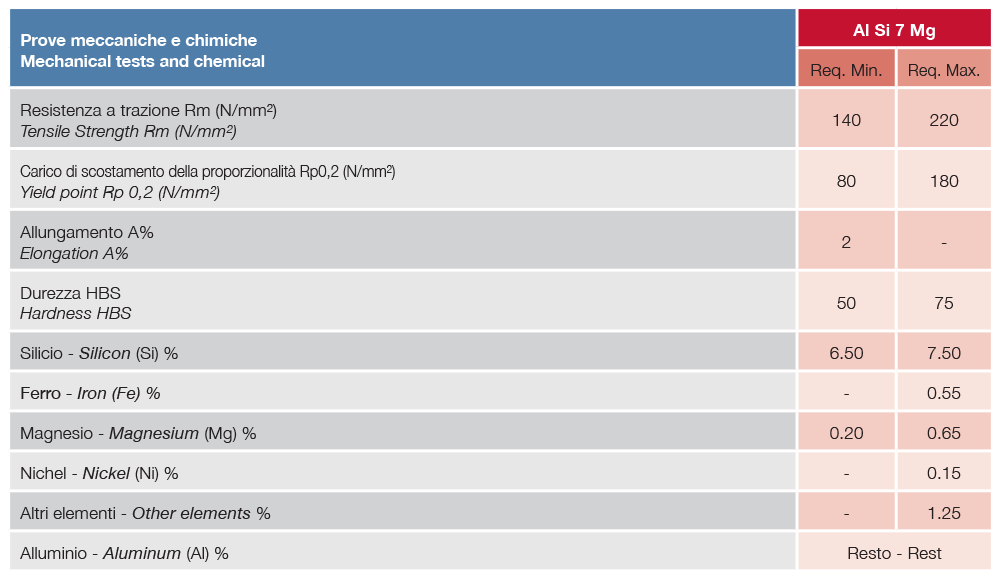[av_section min_height=” min_height_px=’500px’ padding=’default’ shadow=’no-shadow’ bottom_border=’no-border-styling’ id=’ghisa’ color=’main_color’ custom_bg=” src=” attachment=” attachment_size=” attach=’scroll’ position=’top left’ repeat=’no-repeat’ video=” video_ratio=’16:9′ overlay_opacity=’0.5′ overlay_color=” overlay_pattern=” overlay_custom_pattern=”]
[av_heading tag=’h2′ padding=’10’ heading=’CAST IRON’ color=” style=’blockquote modern-quote modern-centered’ custom_font=” size=” subheading_active=” subheading_size=’15’ custom_class=”][/av_heading]
[av_textblock size=” font_color=” color=”]
Cast iron is a ferro-carbon alloy with a purport of carbon between 2.11% and 6.69%. It is obtained from the transformation of haematite in blast furnaces. During the solidification the carbon separates from the metallic mass and is presented as graphite which is dispersed uniformly under the form of thin layers.
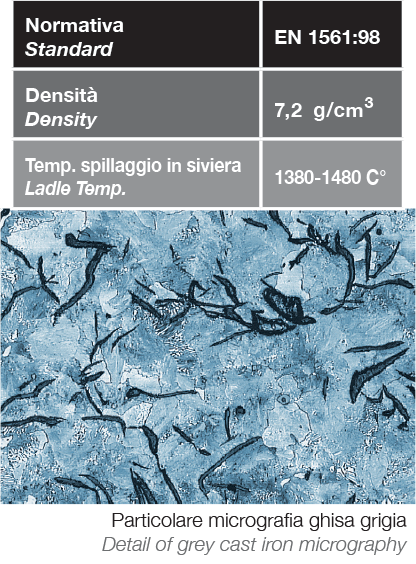 Benefits
Benefits
- strong workability with machine tools;
- good resistance to use and to thermal stress;
- good castability.
Main uses
- components exposed to a low level of mechanical stress;
- industrial sector;
- rail and tramway sectors;
- fireplace and accessories sector;
- nautical sector;
- artistic casting.
The influence of the binding elements
- Silicon: aids the formation of graphitic carbon; it improves its workability with machine tools; it lowers the casting temperature rendering the alloy more fluid.
- Manganese: favours the formation of carbon under the form of cementite; it carries out a de-sulphurizing action; it induces an increase in the breaking load and hardness and raises its level of hardenability.
- Phosphorous: influences the temperature at the end of the solidification and increases the castability of the alloy; it considerably reduces the mechanical properties of resistance and resilience.
- Sulphur: interferes with the formation of the graphite; it induces suction and blow-holes; it influences the mechanical and technological properties in a negative way.
- Molibdenium: aids the the hardenability; it reduces the possibility of cracks and distortions.
- Nickel: decreases the sensitivity to thickness; It improves its resistance to use.
- Chrome: improves the mechanical resistance; it reduces the critical speed of cooling thus improving its hardenability.
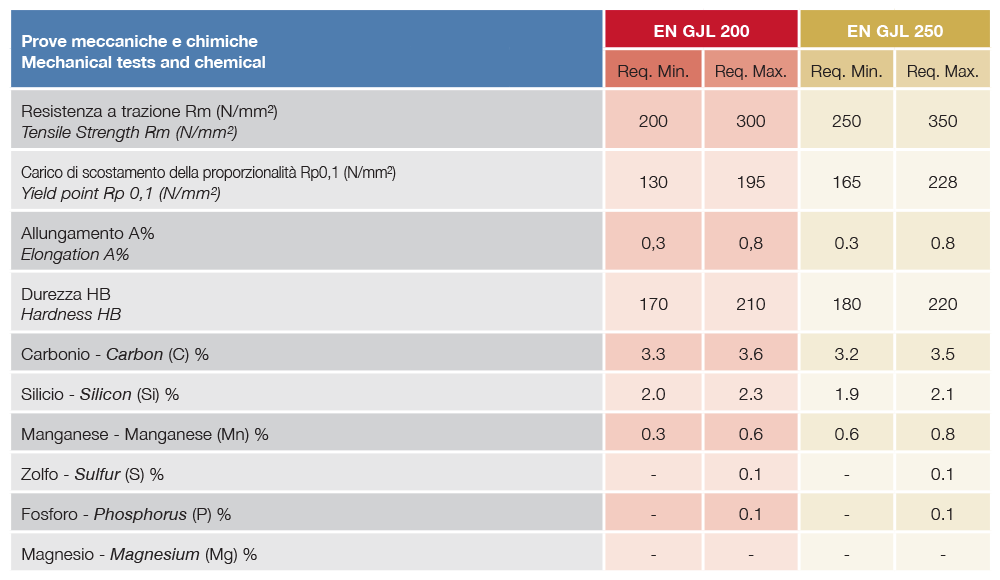
Productions:
Sand casting
Resin sand casting
Automatic line casting
Shell mold casting
[/av_textblock]
[/av_section]
[av_section min_height=” min_height_px=’500px’ padding=’default’ shadow=’no-shadow’ bottom_border=’no-border-styling’ id=’ghisa_sfe’ color=’main_color’ custom_bg=” src=’https://fv-cast.com/wp-content/uploads/2016/04/under1-18-1413814792.jpg’ attachment=’35’ attachment_size=’full’ attach=’fixed’ position=’center center’ repeat=’stretch’ video=” video_ratio=’16:9′ overlay_enable=’aviaTBoverlay_enable’ overlay_opacity=’0.6′ overlay_color=’#162747′ overlay_pattern=” overlay_custom_pattern=”]
[av_heading tag=’h2′ padding=’10’ heading=’DUCTILE CAST’ color=’custom-color-heading’ style=’blockquote modern-quote modern-centered’ custom_font=’#ffffff’ size=” subheading_active=” subheading_size=’15’ custom_class=”][/av_heading]
[av_textblock size=” font_color=’custom’ color=’#ffffff’]
Ductile cast iron is different from grey cast iron because of the disposition of the graphite which presents itself under the form of spheroids (which gives it the name of spheroidal or nodular), in this way eliminating any possible lines of the spreading of its breaking and adding to the aforementioned qualities of grey cast iron four remarkable mechanical characteristics.
Benefits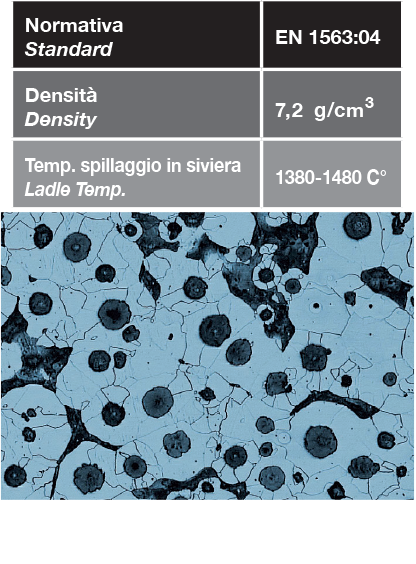
- strong resistance to traction and shocks;
- good elongation;
- high elastic limit;
- good capacity for absorbing vibrations.
Main uses
- products which require a strong resistance to traction;
- hydraulics sector;
- railway sector;
- industrial sector;
- manhole covers.
Since ductile cast iron was discovered (1940) many methods and materials have been adopted and still today we cannot say that the ideal method of spheroidalization for every type of production has been found.
There are more than 25 known methods and of these the first one, the OPEN CASTING LADLE is still the most commonly used today.
The magnesium is placed on the bottom of a well-heated open ladle and then the cast iron poured from the oven at a temperature of 1500 °C.
The glare of the manganese dies down soon after having filled the ladle, spheroidizing the cast iron. This work is carried out in conditions that are both continuous and repetitive with accurate checking of the temperature and the composition of the base iron, weighing the iron that is to be treated and the spheroidizing agent.
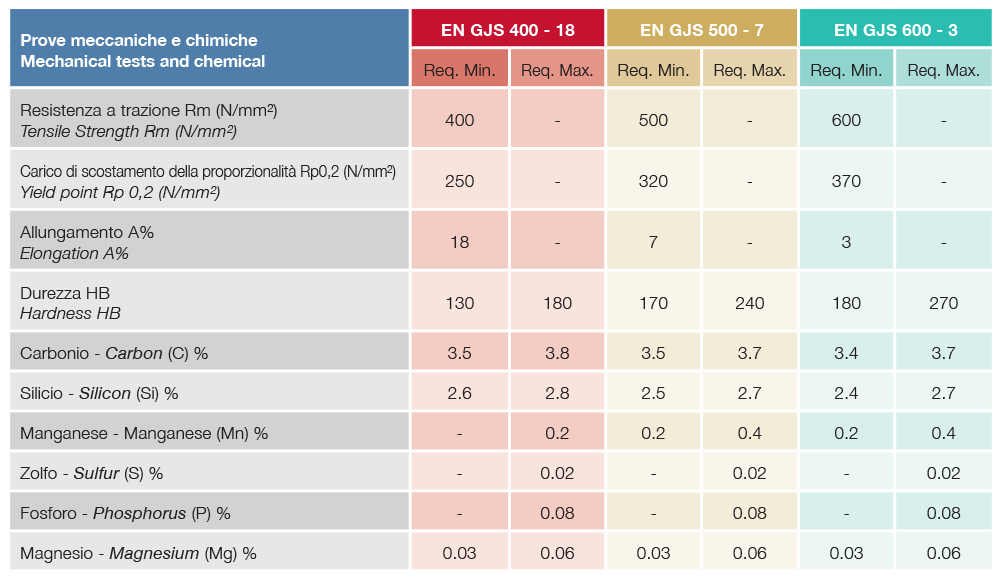
Productions:
Sand casting
Resin sand casting
Automatic line casting
Shell mold casting
[/av_textblock]
[/av_section][av_section min_height=” min_height_px=’500px’ padding=’default’ shadow=’no-shadow’ bottom_border=’no-border-styling’ id=’acciaio’ color=’main_color’ custom_bg=” src=” attachment=” attachment_size=” attach=’scroll’ position=’top left’ repeat=’no-repeat’ video=” video_ratio=’16:9′ overlay_opacity=’0.5′ overlay_color=” overlay_pattern=” overlay_custom_pattern=”]
[av_heading tag=’h2′ padding=’10’ heading=’STEEL’ color=” style=’blockquote modern-quote modern-centered’ custom_font=” size=” subheading_active=” subheading_size=’15’ custom_class=”][/av_heading]
[av_textblock size=” font_color=” color=”]
Steel is an alloy of iron and carbon which contains a percentage of carbon that is less than 2% and even smaller percentages of other elements such as silicon, manganese, sulphur and phosphorus. The mechanical characteristics of the various types of steel mainly depend on their chemical composition, but particularly on the quantity of carbon present and on its distribution in the iron and on the added iron alloys and the thermal treatment it undergoes.
Benefits
- good mechanical properties;
- good workability with the machine tools;
- a high level of weldability;
- good resistance to high pressures.
Main uses
- industrial sector;
- railway sector;
- automotive sector;
- nautical sector.
Steels are divided into 2 fundamental groups: steels which are chosen based on their mechanical characteristics or use. There are also steels that are chosen according to their chemical composition.
There are many denominations established by appropriate technical regulations: in Europe the Euronorme (EN) are laid down by the European Committee of Regulations (CEN), and in America by the ASTM (America Society Testing Materials), in collaboration with the AISI (American Iron and Steel Institute) and on an international scale by the ISO (International Standard Institute).
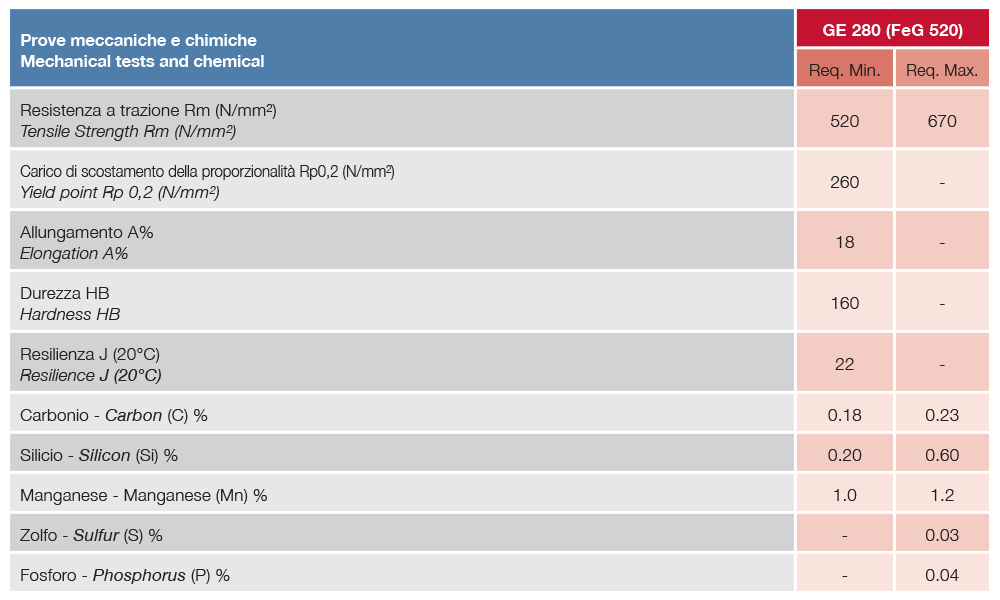
Production:
Lost wax casting
[/av_textblock]
[/av_section][av_section min_height=” min_height_px=’500px’ padding=’default’ shadow=’no-shadow’ bottom_border=’no-border-styling’ id=’inox’ color=’main_color’ custom_bg=” src=’https://fv-cast.com/wp-content/uploads/2016/04/materiali-18-1405069390-20-1413815106.jpg’ attachment=’139′ attachment_size=’full’ attach=’fixed’ position=’center center’ repeat=’stretch’ video=” video_ratio=’16:9′ overlay_enable=’aviaTBoverlay_enable’ overlay_opacity=’0.6′ overlay_color=’#162747′ overlay_pattern=” overlay_custom_pattern=”]
[av_heading tag=’h2′ padding=’10’ heading=’STAINLESS STEEL’ color=’custom-color-heading’ style=’blockquote modern-quote modern-centered’ custom_font=’#ffffff’ size=” subheading_active=” subheading_size=’15’ custom_class=”][/av_heading]
[av_textblock size=” font_color=’custom’ color=’#ffffff’]
Stainless steels are iron alloys which merge the mechanical properties which are typical of steels, with the characteristics of noble materials, such as the considerable resistance to corrosive phenomena. Thanks to the presence of the alloy elements (particularly chrome) they can become “autopassive”, that is they cover themselves with an invisible layer of oxides that protects the underlying metal from corrosion.
Benefits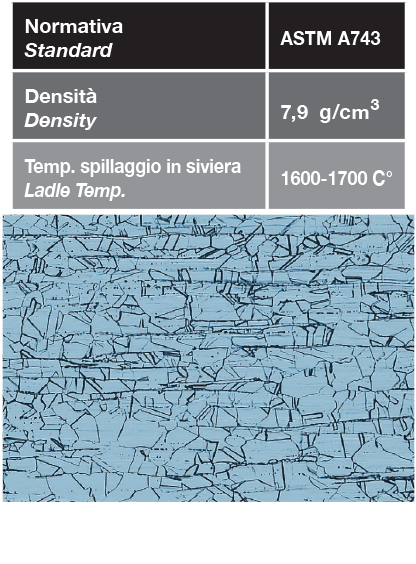
- considerable mechanical property;
- excellent resistance to corrosion;
- good weldability.
Main uses
- industrial sector;
- hydraulics sector;
- aeronautical sector;
- medical sector;
- nautical sector.
The discovery
The Englishman Harry Brealy discovered stainless steel when in 1913, experimenting steels for guns, he found out that a sample of steel with about 14% of chrome and a relatively high content of carbon did not rust if it was exposed to the atmosphere.
The difference beteween AISI 304 and AISI 316
The difference between AISI 304 and AISI 316 stainless steel, apart from the cost, is due to the higher austenicity of the latter thanks to the greater percentage of nickel.
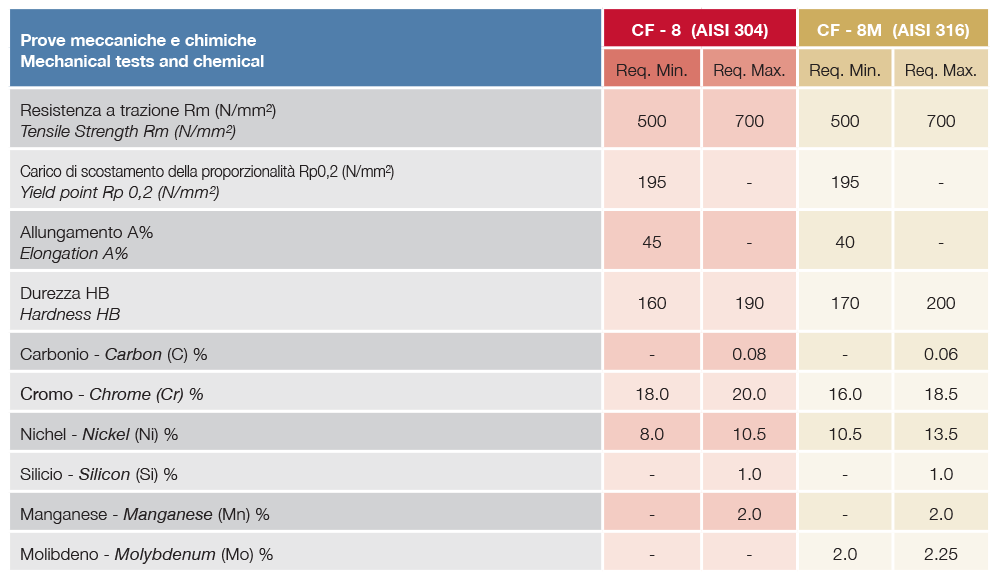
Production:
Lost wax casting
[/av_textblock]
[/av_section][av_section min_height=” min_height_px=’500px’ padding=’default’ shadow=’no-shadow’ bottom_border=’no-border-styling’ id=’inox_duplex’ color=’main_color’ custom_bg=” src=” attachment=” attachment_size=” attach=’scroll’ position=’top left’ repeat=’no-repeat’ video=” video_ratio=’16:9′ overlay_opacity=’0.5′ overlay_color=” overlay_pattern=” overlay_custom_pattern=”]
[av_heading tag=’h2′ padding=’10’ heading=’DUPLEX STAINLESS STEEL’ color=” style=’blockquote modern-quote modern-centered’ custom_font=” size=” subheading_active=” subheading_size=’15’ custom_class=”][/av_heading]
[av_textblock size=” font_color=” color=”]
Steels that can be called Duplex Stainless steel (DSS) or “bi-phasics” are those particular types of stainless steel that are characterised by a mixed structure of austenites and ferrites (austenite steels – ferrites). They normally present a high percentage of Cr (always more than 16 %), a low content of Ni associated with Mo, Si and Mn, which brings about the peculiar characteristic of presenting the above mentioned bi-phasic structure at room temperature.
 Benefits
Benefits
- high mechanical property at room temperature;
- considerable resistance to oxidation at high temperatures;
- considerable resistance to tense corrosion;
- good weldability.
Main Uses
- industrial sector;
- food sector;
- hydraulics sector;
- petrochemical sector.
Resistance to corrosion.
Excellent resistance to localised corrosion (intergranular, pitting and intersticial stress corrosion). The normal CPT is 35°C. The stress corrosion cracking (SCC) or stress-corrosion for the chlorination is over 150°C.
Working temperature
Working temperature must be maintained at between -50°C and 300°C as this material is fragile.

Production:
Lost wax casting
[/av_textblock]
[/av_section][av_section min_height=” min_height_px=’500px’ padding=’default’ shadow=’no-shadow’ bottom_border=’no-border-styling’ id=’alluminio’ color=’main_color’ custom_bg=” src=’https://fv-cast.com/wp-content/uploads/2016/04/under2-21-1413815918.jpg’ attachment=’140′ attachment_size=’full’ attach=’fixed’ position=’center center’ repeat=’stretch’ video=” video_ratio=’16:9′ overlay_enable=’aviaTBoverlay_enable’ overlay_opacity=’0.6′ overlay_color=’#162747′ overlay_pattern=” overlay_custom_pattern=”]
[av_heading heading=’ALUMINIUM’ tag=’h2′ style=’blockquote modern-quote modern-centered’ size=” subheading_active=” subheading_size=’15’ padding=’10’ color=’custom-color-heading’ custom_font=’#ffffff’][/av_heading]
[av_textblock size=” font_color=’custom’ color=’#ffffff’]
When speaking about aluminum in the sector of industry, one is always referring to the aluminum alloys. Indeed, this metal, against an extremely reduced specific weight and an excellent resistance to corrosion, presents some poor mechanical properties. This is why it is always necessary to link it with other metals such as zinc, copper, nickel, magnesium, and silicon.
Benefits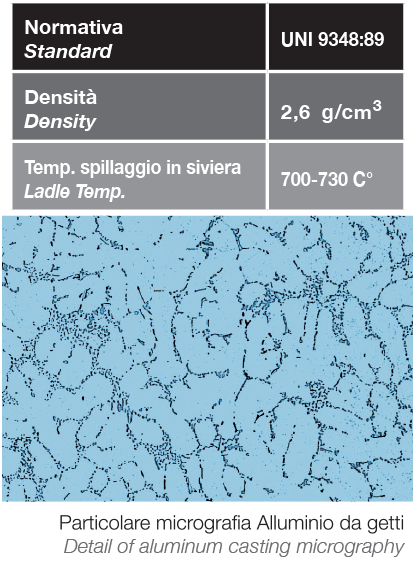
- low specific weight;
- strong resistance to corrosion;
- excellent mechanical resistance (aluminium – copper alloys);
- good castability (Aluminium – silicon alloys);
- good weldability (Aluminium – silicon alloys);
Main uses
- industrial sector;
- automotive sector;
- nautical sector;
- aeronautical sector.
[/av_textblock]
[/av_section]
 Benefits
Benefits






 Benefits
Benefits

